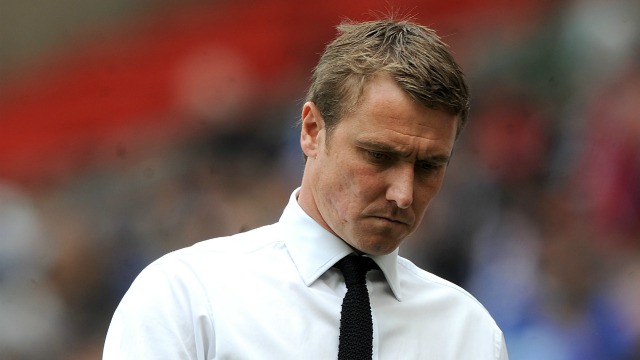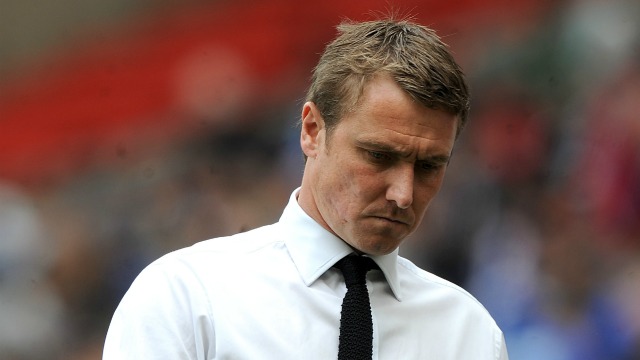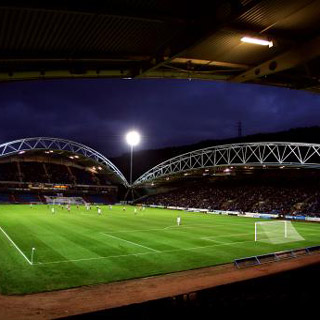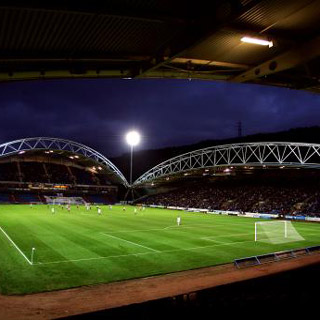The sacking of Lee Clark at Huddersfield Town has sent shockwaves across the world of football, with observers from Henry Winter to Wayne Rooney expressing their shock and dismay at the decision. To the uninformed spectator the decision may seem bizarre, however Huddersfield fans have been far from disappointed at the decision, and some have actively welcomed it. How did a man with only 3 defeats in 55 games come to be sacked? And why have so few fans been unhappy with the news?
At the start of Lee Clark’s tenure there was a positive vibe among the fans, after an encouraging end to the 2008-09 season. The feeling of positivity was matched by the performances on the pitch over the following year. Clark assembled a talented young squad which played a genuine brand of free-flowing attacking football and would eventually finish 6th in the table, racking up 82 goals in the process. Nevertheless, Huddersfield’s soft underbelly and lack of experience would be cruelly exposed by a resilient Milwall side in the play-offs.
The defeat against Milwall would have a terminal effect on the style of play Lee Clark would adopt for the rest of his tenure. Huddersfield clearly needed experience and graft to accompany the undoubtedly talented youngsters at the club. This was reflected by Clark’s signings before the 2010-11 season, with the arrivals of Ian Bennett, Gary Naysmith, Damien Johnson, Joey Gudjonsson and Alan Lee all examples of the experience Clark felt necessary. On paper these signings looked to be exactly what the club needed. However as the season progressed it was clear that some of Clark’s signings were over the hill and simply happy to collect one final pay-packet. This left Town with a squad of youngsters and has-beens with very few players at the peak of their footballing ability.
Despite a promising start to the new campaign Town’s football would become increasingly negative as the season went on. The final blow to Clark’s attacking football would come after a 4-1 mauling at promotion rivals Southampton in late December. This result led Clark to implement a 4-5-1 system for the remainder of the season. Town would subsequently go unbeaten for the rest of the season, and were admittedly unlucky that they were competing against as talented a side as Southampton for the second automatic promotion place. The problem with 4-5-1 was the negativity that accompanied it. Between January 1st and the end of the season, Town won only five games by more than 1 goal and became the divisions draw specialists. Four games at the end of February where Town picked up just 4 points from a possible 12 seriously dented their promotion chances and meant that Town lost too much ground on Southampton to recover.
The play-off final against Peterborough was arguably the crippling blow from which Lee Clark would never really recover. His decision to play 4-5-1 with the 18 year old Benik Afobe as the lone striker ahead of Jordan Rhodes perplexed many fans, even if Rhodes’s form had not been as mercurial at this point. Clark’s tactical shortcomings in this game were not the only thing that annoyed Town fans though. The Peterborough squad had been assembled on a fraction of the budget that Lee Clark had to spend and highlighted just how much money Lee Clark had squandered on players. Clark’s transfer record was a real mixed bag with the signings of Jordan Rhodes, Anthony Pilkington and Lee Peltier seemingly showing he had an eye for a player. However, Clark would sign enough players to have four separate teams in his time at Huddersfield but never one good enough to secure promotion. Signings like Dominik Werling, Alan Lee and Robbie Simpson have been monumental flops in their time at Huddersfield. In addition Clark has never been able to address Huddersfield’s problem area of central midfield, despite a host of signings aimed at addressing the issue.
Clark was rarely able to re-create the feel good factor around the club in the 2011-12 season as fans struggled to recover from the play-off final defeat. There was a growing sense of apathy around the club due to the prospect of another season in League One, with empty stadiums and long ball football. Again, Huddersfield were victim to drawing too many games and sacrificing winning positions and there was a growing feeling that this was down to Clark’s tactical shortcomings. Despite Town still riding high in the table fans were disillusioned with the brand of football they were being made to watch. At the end of the day, football is a form of entertainment and in a time where fans are, more than ever, struggling to justify the high prices of going to watch football, Huddersfield have simply not played an attractive enough brand of football to warrant extortionately high ticket prices.
Furthermore Clark’s man-management skills have come under scrutiny and generally been found wanting. Donal McDermott and Anton Robinson had both impressed for Bournemouth, but were never able to show their ability under Clark. Indeed, as the season wore on, it appeared that some players were scared of playing for Lee Clark. This was in part due to Clark’s increasingly strange team selections, which prevented players from gaining confidence. From one week to the next it was as if the selection was random. Players would go from not even being in the squad for months on end to suddenly being plunged into the starting eleven, Danny Cadamarteri for instance. This scattergun policy to selection prevented Huddersfield from gaining any real consistency and confidence, and this is reflected in the quality of football and entertainment towards the end of Clark’s regime.
Despite all this Clark would probably have kept his job until the end of the season if he had handled his public relations and the media better. At the beginning of his stint as manager Clark talked a good game and his handling of the media helped to raise the club’s profile. However, the 2011-12 season in particular, has seen a markedly different media handling style adopted by Clark. His post-match interviews have been increasingly bullish and have alienated the media and supporters. His refusal to rule himself out of the running for the Leicester job left a sour taste in the mouth for all concerned, and potentially soured the relationship with the board. Poor performances after Christmas combined with him again refusing to rule himself out of vacant managerial positions led to growing disillusionment among the fans. This alienation of supporters led to a lack of confidence in Lee Clark’s ability, and it is this deterioration of trust, more than the results on the pitch, which led to Clark’s position becoming untenable.
Lee Clark should be praised for his 100% commitment and enthusiasm to the cause. Nevertheless Clark has been heavily backed by an ambitious owner and has ultimately failed in his remit of getting Huddersfield to the Championship. The major gripe among Town fans was how much the quality of football has decreased since the beginning of his reign. Though the sacking came as a surprise to many pundits, those who have followed Clark and Huddersfield this season understand the sacking was justified. His comments to the media have made him seem, at times, deluded and desperate – especially in the wake of the defeat to Sheffield United. Dour football combined with a deteriorating media relationship have meant that, bizarrely, despite a 43 game unbeaten run, Clark’s sacking is understandable. Despite the claims of footballing contemporaries Lee Clark’s sacking is not an example of ‘football gone mad’ and the actions of an egotistical chairman, but instead the actions of a man well within his rights to call time on a failing regime.
Follow us on twitter (JThorn26) (@spoughtsblog)




